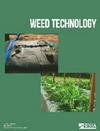与土壤施用残留除草剂相比,遮荫、大豆行距和绿化对马鞭草管理的贡献
IF 1.7
3区 农林科学
Q3 AGRONOMY
引用次数: 0
摘要
对密歇根州的大豆种植者来说,抗草甘膦(GR)的马鞭草是一种有问题的杂草。此外,在密歇根州的几个田地里,观察到莲座状和直立状的马鞭草生长类型在夏中下旬同时出现。在温室中,与在0%遮荫下生长的直立生长型相比,35%至92%的遮荫水平使莲座花和直立马鞭的生物量减少了31%至99%。在69%和92%的遮荫下,生物量减少幅度更大。因此,通过窄行种植和/或在谷类黑麦中种植绿色植物来增加遮荫,可以提高对马鞭草的抑制作用。一项为期三年的田间试验比较了秋季种植的黑麦在种植(绿色种植)后1周用草甘膦终止的效果,以及发芽前(PRE)残留除草剂计划(草甘膦+2,4-D+氟米恶嗪+美曲布津)对种植三行宽(19-、38-和76cm)的大豆的马鞭草控制效果。与种植后4至6周在76厘米行中无覆盖种植的大豆相比,在所有行宽上种植绿色或施用残留除草剂计划分别降低了马鞭生物量86至91%和95至99%(WAP)。在大豆收获时,当施用无效的出苗后(POST)除草剂(草甘膦)时,通过种植绿色或施用残留除草剂计划,与无覆盖相比,马草生物量分别降低了42%和81%。同样,与38厘米和76厘米的行相比,19厘米的行种植大豆减少了马鞭生物量。当应用有效的POST程序时,通过在所有行宽上种植绿色或施用残留除草剂,观察到类似的马鞭生物量减少。此外,种植绿色作物和施用残留除草剂的大豆产量和经济回报在两年中的一年是相似的。将种植绿色和有效的POST除草剂计划相结合,为应用残留早熟除草剂计划提供了一种替代性的马鞭草管理策略。本文章由计算机程序翻译,如有差异,请以英文原文为准。
Contributions of shading, soybean row-width, and planting green on horseweed management compared with soil-applied residual herbicides
Glyphosate-resistant (GR) horseweed is a problematic weed for Michigan soybean growers. Additionally, rosette- and upright- horseweed growth types have been observed co-emerging during mid- to late-summer in several Michigan fields. In the greenhouse, shade levels from 35 to 92% reduced rosette and upright horseweed biomass 31 to 99% compared with the upright growth type grown under 0% shade. Greater reductions in biomass occurred under 69 and 92% shade. Thus, increased shading by planting in narrow rows and/or planting green into cereal rye may improve horseweed suppression. A field experiment conducted over three site-years compared the effect of fall-planted cereal rye terminated with glyphosate 1 wk after planting (planting green) with a preemergence (PRE) residual herbicide program (glyphosate + 2,4-D + flumioxazin + metribuzin) on horseweed control in soybean planted in three row widths (19-, 38-, and 76-cm). Planting green or applying a residual herbicide program across all row widths reduced horseweed biomass 86 to 91% and 95 to 99%, respectively, compared with soybean planted with no cover in 76 cm rows, 4 to 6 wk after planting (WAP). At soybean harvest, when a noneffective postemergence (POST) herbicide (glyphosate) was applied horseweed biomass was 42 and 81% lower by planting green or applying a residual herbicide program compared with no cover, respectively. Similarly, planting soybean in 19 cm rows reduced horseweed biomass compared with 38- and 76-cm rows. When an effective POST program was applied, similar horseweed biomass reductions were observed by planting green or applying a residual herbicide across all row widths. Additionally, soybean yield and economic returns were similar between planting green and applying a residual herbicide in 1 of 2 site-years. Integrating planting green and an effective POST herbicide program offers an alternative horseweed management strategy to applying a residual preemergence herbicide program.
求助全文
通过发布文献求助,成功后即可免费获取论文全文。
去求助
来源期刊

Weed Technology
农林科学-农艺学
CiteScore
2.90
自引率
21.40%
发文量
89
审稿时长
12-24 weeks
期刊介绍:
Weed Technology publishes original research and scholarship in the form of peer-reviewed articles focused on understanding how weeds are managed.
The journal focuses on:
- Applied aspects concerning the management of weeds in agricultural systems
- Herbicides used to manage undesired vegetation, weed biology and control
- Weed/crop management systems
- Reports of new weed problems
-New technologies for weed management and special articles emphasizing technology transfer to improve weed control
-Articles dealing with plant growth regulators and management of undesired plant growth may also be accepted, provided there is clear relevance to weed science technology, e.g., turfgrass or woody plant management along rights-of-way, vegetation management in forest, aquatic, or other non-crop situations.
-Surveys, education, and extension topics related to weeds will also be considered
 求助内容:
求助内容: 应助结果提醒方式:
应助结果提醒方式:


